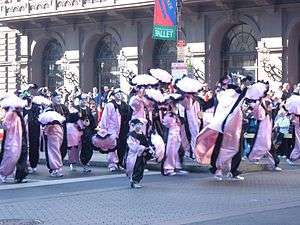Mummers Parade
| Mummers Parade | |
|---|---|
|
A group of "comic" mummers in the 2005 parade | |
| Genre | Parade |
| Date(s) | New Year's Day |
| Frequency | Annual |
| Location(s) | Philadelphia, Pennsylvania, United States |
| Years active | 115 |
| Inaugurated | January 1, 1901 (first official parade) |
| Most recent | January 1, 2016 |
| Website | |
| phillymummers.com | |
The Mummers Parade is held each New Year's Day in Philadelphia, Pennsylvania, USA. It is believed to be the oldest folk festival in the United States.[1]
Local clubs (usually called "New Years Associations") compete in one of four categories (comics, fancies, string bands, and fancy brigades). They prepare elaborate costumes, performance routines, and moveable scenery, which take months to complete. This is done in clubhouses – many of which are on or near 2nd Street (called "Two Street" by some local residents)[2] in the Pennsport neighborhood of the city's South Philadelphia section – which also serve as social gathering places for members.
The parade has been broadcast since 1993 on WPHL-TV,[3] which has live streamed the event on its website since 2011. After a national campaign to get the parade nationally televised,[4] an edited two-hour broadcast of the parade was picked up by WGN America and WGN-TV; the broadcast debuted January 3, 2009.
History
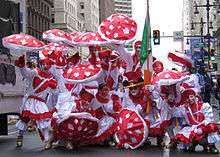
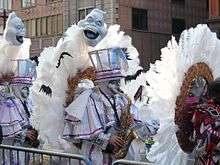
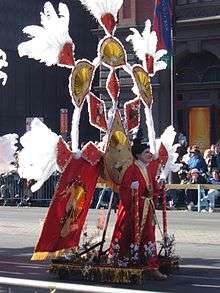
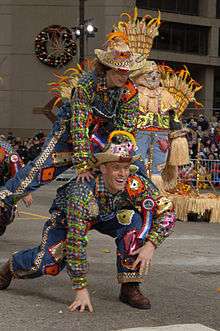
The parade traces back to mid-17th-century roots, blending elements from Swedish, Finnish, Irish, English, German, and other European heritages, as well as African heritage.[5][6] The parade is related to the Mummers Play tradition from Britain and Ireland.[7] Revivals of this tradition are still celebrated annually in South Gloucestershire, England on Boxing Day along with other locations in England and in parts of Ireland on St. Stephen's Day and also in the Canadian province of Newfoundland and Labrador around Christmas.
Swedes and Finns, the first European colonists in the Philadelphia area, brought the custom of visiting neighbors on "Second Day Christmas" (December 26) with them to Tinicum. This was soon extended through New Year's Day with costumed celebrants loudly parading through the city.[7][8] They appointed a "speech director", who performed a special dance with a traditional rhyme:
| “ | Here we stand before your door, As we stood the year before; Give us whiskey; give us gin, |
” |
The Mummers derive their name from the Mummers' plays performed in Philadelphia in the 18th century as part of a wide variety of working class street celebrations around Christmas. By the early 19th century, these coalesced with earlier Swedish customs, including the Christmas neighbor visits and possibly shooting firearms on New Year's Day (although this was common in other countries as well) as well as the Pennsylvania German custom of "belsnickling," where adults in disguise questioned children about their behavior during the previous year.[11]
U.S. President George Washington carried on the official custom of New Year's Day calls during the seven years he occupied President's House in Philadelphia. The Mummers continued their traditions of comic verse in exchange for cakes and ale. Small groups of up to twenty mummers, their faces blackened, went door to door, shooting and shouting, and adapting the English Mummer's play by replacing the character of "King George" with that of "General Washington."[9]
Through the 19th century, large groups of disguised (often in blackface) working class young men roamed the streets on New Year's Day, organizing "riotous" processions, firing weapons into the air, and demanding free drinks in taverns, and generally challenging middle and upper-class notions of order and decorum.[11]
An 1808 law decreed that "masquerades" and "masquerade halls" were "common nuisances" and that anyone participating would be subject to a fine and imprisonment. It was apparently never successfully enforced and was repealed in 1859.[9][12][13]Henry Muhlenberg, writing in 1839, reported, "Men met on the roads in Tinicum and Kingsessing, who were disguised as clowns, shouting at the top of their voices and shooting guns.[9]
Unable to suppress the custom, by the 1880s the city government began to pursue a policy of co-option, requiring participants to join organized groups with designated leaders who had to apply for permits and were responsible for their groups actions. The earliest documented club, the Chain Gang, had formed in 1840 and Golden Crown first marched in 1876 with cross-town rivals Silver Crown forming soon after. By 1881, a local report said "Parties of paraders" made the street "almost like a masked Ball."[13] By 1900, these groups formed part of an organized, city-sanctioned parade with cash prizes for the best performances.[11]
Southern plantation life's contributions include the parade's theme song, James A. Bland's "Oh, Dem Golden Slippers" (introduced in 1903), as well as the 19th-century cakewalk, dubbed the "Mummers' Strut" or the "2 Street Strut".[5][8]
The first official parade was held January 1, 1901. The first string band, Trilby, was organized in 1898, first paraded in 1902, and last paraded in 1924. In the early years of the official parade, the makeshift costumes of most celebrants were gradually replaced by more elaborate outfits funded by associations' fund-raising efforts.[5]
As they assimilated to Philadelphia, many immigrant groups have joined the tradition. Numerous Irish immigrants and Irish-Americans from South Philadelphia became involved in the Mummers Parade as both Mummers performers and parade goers. Other ethnic groups were soon integrated into the parade through the years. Italian-Americans and Italian immigrants to South Philadelphia began to participate in the Mummers Parade in large numbers after World War II.[14][14] While South Philadelphia (especially Pennsport) remains one of the most important centers for Mummers traditions and Mummers members, more recent immigrants to the neighborhood from Asia and Latin America generally have fewer ties to the parade and tradition.[15]
While almost all parade participants are currently white, African American mummers existed in the past. The all African American Golden Eagle Club, formed in 1866, had 300 members in the 1906 parade, for example. Judges systematically discriminated against black clubs, however, and the last, the Octavius Catto Club, withdrew after receiving last place in the 1929 parade.[16] The brass bands hired to accompany the Comic Brigades often include black musicians, but do not dress in costume and consider themselves session musicians rather than Mummers. By 1964, only one African American mummer, Willis Fluelling, remained.[17] As of 2007, a few of the less traditional clubs, such as Spiral Q Puppet Theater's. West Philadelphia Mummers Brigade, were integrated.
The comic "wenches" and other female roles in most skits are typically performed by men in drag.[18] Women were not officially allowed in the parade until the 1970s.[13][18]
Budget problems
As of 2008, the parade cost the city over $1 million each year, including $750,000 for police and parade services and $360,000 in prize money. The 2008 budget crisis led the city to propose closing numerous libraries and firehouses and the scaling back of expenditures for the parade, offering $300,000 for the 2009 parade and nothing for 2010.[19][20]
After the end of city funding for the parade, the Mummers created the "Save the Mummers Fund" to help cover the additional city fees to paying expenses for police and sanitation services during the event.[21]
Funding for the parade during the first decade of the 2000s was provided for several years by Southwest Airlines, which also took naming rights of the parade, which was called "Southwest Airlines Mummers Parade." Funding for the 2012 parade was provided by SugarHouse Casino, which renamed the parade to "Sugar House Mummers Parade." [22]
In September 2009, The Bacon Brothers musical duo (comprising Philadelphia natives Michael and Kevin Bacon) recorded a special version of their song "New Year's Day" with members of the All-Star String Band.[23] Proceeds from the sale of the CD went to the Save the Mummers Fund.[21] Additionally, the duo performed a benefit concert for the parade in December 2009.[24]
Location, time and route
The parade traveled northward on Broad Street in Philadelphia for decades until the 1995 parade when the parade was moved to Market Street due to construction work on Broad Street (notably the "Avenue of the Arts" between Washington Avenue and Philadelphia City Hall). After construction was completed, the parade returned to Broad Street from 1996 to 1999. For various reasons, the parade was moved again to Market Street in 2000. In 2004, the parade was moved back to Broad Street. In 1997, the Fancy Brigades were moved to the Pennsylvania Convention Center, allowing for larger sets, but limiting audience size. In 2011, the Fancy Brigades returned to the parade.
Each year, thousands of people participate in the parade, many wearing elaborate costumes costing tens of thousands of dollars to make and weighing well over 100 pounds.[13][18] $395,000 in prizes is awarded to the various winners.[25] The costs for making the outfits plus fees to choreographers and prop designers often far exceed the prizes available. While club fund-raisers, hall rentals and bank loans often cover much of the expense, individual members frequently spend hundreds or thousands of dollars of their own money.[18] To raise funds, many string bands and their members seek paying gigs, particularly in area Fourth of July parades, the annual "Show of Shows" (held in Atlantic City, New Jersey, each winter), weddings and other events. Many clubs hold "beef and beers" or 50/50 raffles. Most charge annual dues for membership.[26]
As of 2008, the parade began at 9:00 am and ended sometime before 8:00 pm. fancy brigades performed at the nearby convention center at noon and, in a second, judged show, at 5:00 pm.[2] An individual Mummers' strut – a weaving, comical dance/walk with pumping arms held out to the side – may last two or three hours from South Philadelphia to City Hall. The whole parade, at close to eleven hours, may have been the longest parade in the U.S.[18] Due to budget cuts, the 2009 parade was shorter, scheduled to begin at 10:00 am and last six and a half hours.[19][27]
Incidents of foul weather have delayed the parade on occasions by several hours, including 2008.[28]
On January 1, 2015, the Mummers will begin their parade route at Philadelphia’s City Hall and head south along Broad Street to Washington Avenue. The Mummers will use the Benjamin Franklin Parkway as a staging area prior to moving to City Hall to be judged. After the judging, the mummers will join the parade heading south on Broad St. The parade would end at Washington Ave, with some clubs still heading east to Second Street for the unofficial “Two Street Parade”.[29]
If an all-day postponement is required for foul weather, the parade is usually held the following Saturday (or Sunday, if Saturday is inclement), as the expensive and fancy costumes are easily harmed by precipitation or high winds.
Each year, there is a festival leading up to the parade called MummersFest. It allows fans to tour the Pennsylvania Convention Center to watch the Fancy Brigades build their props and practice for their New Year's Day reveal.
2nd Street
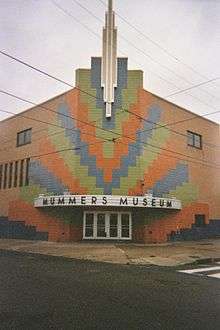
Because of the large number of clubhouses there, South 2nd Street (Two Street) often serves as a party location after the parade, with the center of activity being South 2nd Street and Mifflin Street. Local residents and others in the area for the parade crowd the local bars, clubhouses and sidewalks, sometimes joining in the unofficial parade. With the parade they spent months preparing for finished, the Mummers let loose and celebrate. This multi-block party continues well into the night or early morning, with some Mummers not sleeping for twenty-four hours straight.[2][30]
In 2009, the city declined to pay for any post-parade celebrations on Two Street.[27] However, Rep. Bob Brady helped secure funding for the event in the final hours.[31]
Blackface
The wearing of blackface carried over from minstrel shows in the early 20th century.[32] Growing dissent from civil-rights groups and the offense of the black community led to most clubs phasing out blackface in the early 1960s. A 1964 city policy officially banned blackface,[13][33] but some groups have continued to wear blackface into the 21st century over growing protests.[34]
Divisions
Comics
Comics are clowns, many of them well-liquored,[27] in colorful outfits, often with multi-level umbrellas who dance to recordings such as "Golden Slippers". The comics typically start the parade. Themes often gently parody current events and traditional life. Prizes are awarded for floats, groups, brigades, couples, original costume, original character, and juvenile.
The comic clubs are
Wench brigades, an offshoot of comics, pride themselves on continuing traditions such as the dress-and-bloomers "suits", painted faces, decorated umbrellas, and live brass bands to accompany the brigade.[39] Wench brigades include Bryson, Cara Liom, Froggy Carr, O'Malley, Oregon, Pirates, Riverfront, Saints, Americans and Mollywoppers.
Fancies
The fancy division is made up of four mother clubs:
Members with some small floats strut in elaborate costumes to music provided by a live band.[27] Prizes are awarded to individuals, trios, juveniles and captains.
String bands
String bands provide elaborate performances. Limited to unamplified strings, reeds, and percussion, string bands feature banjos, saxophones (alto, tenor, baritone and bass), accordions, double basses, drums, glockenspiels and violins in musical arrangements tied to a theme presented by the captain, beautiful costumes and props (some people call them floats). Historically, string bands performed mostly in military-drill formations. Harrowgate (now Uptown) String Band's first-prize-winning railroad tunes with Broadway-style dance in 1976 changed that. String-band performances are now the most elaborate of the parade, outdone only by the fancy brigades indoor performance.[18]
String bands include:
Fancy brigades
The largest category with the largest crews, the fancy brigades march the southernmost portion of the parade route, before heading to the convention center for a ticketed show and judging.[27] Until the late 1970s, the fancy brigades were simply larger presentations within the Fancies.[56] As the props grew larger, more cumbersome and more vulnerable to wind, rain and snow, the decision was made to move the Brigades indoors.
Fancy brigades include:
See also
References
- ↑ Todt, Ron (January 1, 2012). "Mummers Strut Down Broad Street in Annual Parade". WCAU-TV. Retrieved January 3, 2012.
- 1 2 3 Max L. Raab (2001). Strut! The Movie (DVD). Philadelphia: Max L. Raab Productions.
- ↑ "SugarHouse Announces Presenting Sponsorship of 2012 Mummers Parade and Fancy Brigade Finale," Business Wire, Friday, November 18, 2011.
- ↑ "National TV Campaign Website". Mummersonnationaltv.com. Archived from the original on July 14, 2011. Retrieved August 14, 2011.
- 1 2 3 "Mummers Parade History". Philadelphia Department of Recreation. Retrieved November 27, 2007.
- ↑ Tadeushuk, Patrick (March 29, 2007). "Special, History – Mummers Museum". Fieldtrip.com. Retrieved August 14, 2011.
- 1 2 "Multicultural Views: Traditional Gardens, Palm-Weaving, Khmer Arts, and Mummery". Philadelphia Folklore Project. 1992. Archived from the original on January 6, 2008.
- 1 2 3 "The Philadelphia Tradition". Philadelphia Mummers Association. Retrieved November 27, 2007.
- 1 2 3 4
- ↑ Welch, Jr., Charles E. (October–Dec 1966). ""Oh, Dem Golden Slippers": The Philadelphia Mummers Parade". Journal of American Folklore. The Journal of American Folklore, Vol. 79, No. 314. 79 (314): 523–536. doi:10.2307/538218. JSTOR 538218. Check date values in:
|date=(help) - 1 2 3 Davis, Susan G. (Summer 1982). "Making Night Hideous: Christmas Revelry and Public Order in Nineteenth-Century Philadelphia". American Quarterly. 34 (2): 185–199. doi:10.2307/2712609. JSTOR 2712609.
- ↑ Marion, John Francis (January 1981). Smithsonian.
- 1 2 3 4 5 "On New Year's Day in Philadelphia, Mummer's the Word". rivefrontmummers.com. Archived version retrieved January 4, 2008.
- 1 2 Richard N. Juliani (1992). "Uses of Tradition: Arts of Italian Americans in Philadelphia". Philadelphia Folklore Project. Archived from the original on January 6, 2008.
- ↑ Hepp, Chris (August 7, 2014). "Mummers Parade going south? City mulls big change". Philadelphia Inquirer. Retrieved February 2, 2015.
- ↑ Welch, Charles E., Jr. (Oct–Dec 1966). ""Oh, Dem Golden Slippers": The Philadelphia Mummers Parade". Journal of American Folklore. 79 (314): 523–536. doi:10.2307/538218. JSTOR 538218.
- ↑ Guendelsberger, Emily (2013-12-19). "Why blackface still dogs the Mummers 50 years after it was banned". Philadelphia CityPaper.
- 1 2 3 4 5 6 DeLeon, Clark (Winter 1984/1985). "Mummers on Parade". National Geographic.
- 1 2 "Shortened 2009 Strut?". Philadelphia Metro. December 15, 2008.
- ↑ Philadelphia Daily News. December 29, 2008. Retrieved December 30, 2008.
- 1 2 Bayliss, Kelly (June 17, 2009). "Kevin Bacon Wants To Save the Mummers". WCAU. Retrieved January 3, 2012.
- ↑ "Sugarhouse Casino Press Release". Sugarhousecasino.com. Retrieved January 11, 2011.
- ↑ Highsmith, Steve (June 17, 2009). "The Mummers and Kevin Bacon – The Bacon Brothers Band Were Joined in a Philadelphia Studio To Record a Version of Their Song, New Year's Day, with Actual Philly Mummers!". WPHL-TV. Retrieved January 3, 2012.
- ↑ Staff (December 5, 2009). "Bacon Brothers Mummers Concert – Help Kevin Bacon and the Bacon Brothers Save the Mummers! – Visit www.savethemummers.com To Make a Donation". WPHL-TV. Retrieved January 3, 2012.
- ↑ "If You Go: Mummers Parade 2008". Philadelphia Metro. December 28, 2007.
- ↑ Strauss, Robert. (December 29, 2008). "Mummers, Dollars and Change". Philadelphia Daily News. Retrieved December 30, 2008.
- 1 2 3 4 5 "Another Year of Mummery". Philadelphia Metro. December 30, 2008.
- ↑ "A Late Start to Mummers Parade". philly.com. January 1, 2008. Archived from the original on January 4, 2008. Retrieved January 1, 2008.
- ↑ http://www.mrmummer.com/2015-mummers-parade-route/
- ↑ Dubin, Murray (June 1996). South Philadelphia; Mummers, Memories, and the Melrose Diner. Temple University Press. ISBN 1-56639-429-5.
- ↑ Carey, Art (January 1, 2009). "Brady Steps In To Save Two Street". The Philadelphia Inquirer. Archived from the original on January 15, 2009. Retrieved January 22, 2009.
- ↑ John-Hall, Annette (December 26, 2007). "A Photojournalist Shows There's More to Mummers Than Feathers, Wigs and a Racist Past". "'Minstrel shows were huge in Philly at the turn of the century,' said Kennedy, explaining the origins of blackface Mummery. 'There were even ads for minstrel shows in the Philadelphia Tribune. The string bands are a direct descendant of the minstrel shows and vaudeville.'" The Philadelphia Inquirer. Retrieved January 9, 2008.
- ↑ Tom, Brittany. the grio.com, January 3, 2013, "Philadelphia’s Mummers parade features blackface performance." Accessed January 3, 2016.
- ↑ More Diverse Mummers Parade Marred by Homophobic, Racist Acts (Jan. 1, 2016)
- ↑ "Goodtimes homepage". Goodtimersnya.homestead.com. Retrieved August 14, 2011.
- ↑ archive of Landi homepage
- ↑ "Froggy Carr homepage". Froggycarr.homestead.com. Retrieved August 14, 2011.
- ↑ "Murry homepage". Hometown.aol.com. Retrieved August 14, 2011.
- ↑ "Wench Brigade Association" (PDF). Archived from the original (PDF) on September 30, 2015. Retrieved January 2, 2012.
- ↑ "Golden Sunrise homepage". Goldensunrise.net. Retrieved August 14, 2011.
- ↑ "Hog Island homepage". Webcitation.org. Archived from the original on October 26, 2009. Retrieved August 14, 2011.
- ↑ "Avalon homepage". Avalonstringband.com. Retrieved August 14, 2011.
- ↑ "Broomall homepage". Broomallstringband.com. Retrieved August 14, 2011.
- ↑ "Duffy homepage". Duffystringband.com. March 16, 2011. Retrieved August 14, 2011.
- ↑ "Durning homepage". Durningstringband.com. Retrieved August 14, 2011.
- ↑ Wedemeyer, Charles. "The Ferko Band of Philadelphia (homepage)". Ferko.com. Retrieved August 14, 2011.
- ↑ "Fralinger homepage". Fralinger.org. Retrieved August 14, 2011.
- ↑ "Greater Kensington homepage". Gksb.com. Retrieved August 14, 2011.
- ↑ "Greater Overbrook homepage". Overbrookstringband.com. Retrieved August 14, 2011.
- ↑ "Polish American homepage". Polishamericanstringband.com. Retrieved August 14, 2011.
- ↑ "Quaker City homepage". Quakercitystringband.com. Retrieved August 14, 2011.
- ↑ "South Philadelphia homepage". Southphillystringband.com. Retrieved August 14, 2011.
- ↑ "Trilby homepage". Originaltrilbystringband.com. Archived from the original on August 23, 2011. Retrieved August 14, 2011.
- ↑ Uptown String Band. "Uptown homepage". Uptownstringband.com. Retrieved November 20, 2011.
- ↑ "Woodland homepage". Woodlandstringband.org. Retrieved November 20, 2011.
- ↑ "Fancy Brigade Association History". Retrieved January 2, 2012.
- ↑ "2nd Street Shooters homepage". 2ndstreetshooters.homestead.com. Retrieved November 20, 2011.
- ↑ "Cahills homepage". Cahillsnya.com. Retrieved November 20, 2011.
- ↑ "Clevemore homepage". Clevemore.com. March 12, 2011. Retrieved November 20, 2011.
- ↑ "Downtowners homepage". Downtowners.org. Retrieved November 20, 2011.
- ↑ "Jokers homepage". Homestead.com. Retrieved November 20, 2011.
- ↑ "Satin Slipper homepage". Slippernyb.homestead.com. Retrieved November 20, 2011.
- ↑ "Saturnalian homepage". Saturnaliannya.com. October 21, 2011. Retrieved November 20, 2011.
- ↑ "Spartans homepage". spartansnyb.org. November 5, 2014. Retrieved November 5, 2014.
- ↑ "Shooting Stars homepage". Shootingstarsnyb.homestead.com. Retrieved November 20, 2011.
- ↑ "South Philly Vikings homepage". Southphillyvikings.com. Retrieved November 20, 2011.
Further reading
| Wikimedia Commons has media related to Mummers Parade. |
- Kennedy, E.A. (2007). Life, Liberty, and the Mummers. Temple University Press. ISBN 978-1-59213-588-2. (reviewed with excerpt in Chronicle of Higher Education. Nov. 23, 2007 p. B19.)
- Masters, P. (2007). The Philadelphia Mummers: Building Community Through Play. Temple University Press. ISBN 978-1-59213-610-0.
